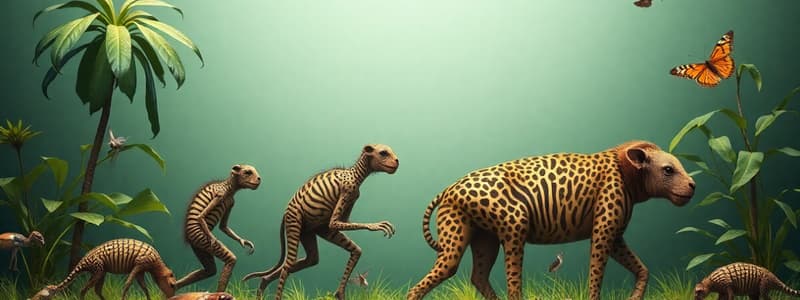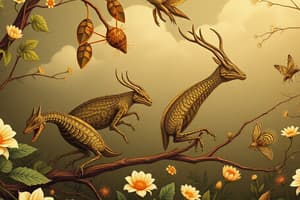Podcast
Questions and Answers
The diagram at right illustrates
The diagram at right illustrates
- Sexual selection
- Disruptive selection (correct)
- Directional selection
- Stabilizing selection
- No selection.
The following statement is NOT one of the six key elements of the modern theory of evolution
The following statement is NOT one of the six key elements of the modern theory of evolution
- Adaptations are environmentally determined characteristics that improve an organism's ability to reproduce. (correct)
- Small changes over many generations can lead to fundamentally different organisms
- All species share a common descent
- Hereditary beneficial adaptations improve an organism's ability to survive and reproduce
- Some genetic changes are not driven by natural selection
Disruptive selection is defined as a mode of selection in which
Disruptive selection is defined as a mode of selection in which
- Intermediate phenotypes are advantageous
- Phenotypes at the lower extreme of the population distribution are disadvantageous
- Phenotypes at the upper extreme of the population distribution are disadvantageous
- Phenotypes at both extremes of the population distribution are advantageous (correct)
- None of the above.
The following statement is true of allopatric speciation.
The following statement is true of allopatric speciation.
Punctuated equilibrium
Punctuated equilibrium
Post-zygotic mechanisms preventing gene flow between two populations of closely related organisms include
Post-zygotic mechanisms preventing gene flow between two populations of closely related organisms include
Under the biological species concept, individuals of the same species
Under the biological species concept, individuals of the same species
A genetic bottleneck
A genetic bottleneck
Which statement about an organism's niche is false?
Which statement about an organism's niche is false?
A mouse that eats plant-eating insects is a/an?
A mouse that eats plant-eating insects is a/an?
Which of the following result(s) in nutrient transfer between ecosystems?
Which of the following result(s) in nutrient transfer between ecosystems?
Which of the following are correct units for measuring primary productivity?
Which of the following are correct units for measuring primary productivity?
Why are some redwood trees over 1000 years old?
Why are some redwood trees over 1000 years old?
Which of the following is NOT a symbiosis?
Which of the following is NOT a symbiosis?
The lion is classified in the
The lion is classified in the
If two organisms are in the same Kingdom, they must be in the same
If two organisms are in the same Kingdom, they must be in the same
The basic unit of taxonomic classification is the
The basic unit of taxonomic classification is the
Grouping 1 in the diagram at right is
Grouping 1 in the diagram at right is
Cladistic analysis places the birds in the same group as
Cladistic analysis places the birds in the same group as
Which group(s) is/are eukaryotic?
Which group(s) is/are eukaryotic?
The microbiological term that describes the rod shape of a bacterium is
The microbiological term that describes the rod shape of a bacterium is
Which structure is utilized for locomotion in Amoeba?
Which structure is utilized for locomotion in Amoeba?
What is the defining characteristic of viruses according to their structure?
What is the defining characteristic of viruses according to their structure?
Which of the following represents a bacterium that thrives in high-pressure environments?
Which of the following represents a bacterium that thrives in high-pressure environments?
What is the typical size range of viruses?
What is the typical size range of viruses?
Which group of microorganisms possesses a nucleus?
Which group of microorganisms possesses a nucleus?
Which spore dispersal mechanism is accurately described for Riccia?
Which spore dispersal mechanism is accurately described for Riccia?
What is the primary characteristic that distinguishes a sorus?
What is the primary characteristic that distinguishes a sorus?
How do moss and liverwort characteristics differ regarding capsule structure?
How do moss and liverwort characteristics differ regarding capsule structure?
Which plant group exhibits a long-lived sporophyte compared to its gametophyte?
Which plant group exhibits a long-lived sporophyte compared to its gametophyte?
What feature differentiates the reproductive structures of cycads from other gymnosperms?
What feature differentiates the reproductive structures of cycads from other gymnosperms?
Which structure in flowering plants is equivalent to the female gametophyte?
Which structure in flowering plants is equivalent to the female gametophyte?
The characteristic of having small leaves is associated with which plant group?
The characteristic of having small leaves is associated with which plant group?
In land plants, the alternation of generations includes which critical requirement?
In land plants, the alternation of generations includes which critical requirement?
Flashcards
Directional Selection
Directional Selection
A type of natural selection where one extreme of a trait becomes more common and favored.
Disruptive Selection
Disruptive Selection
Natural selection where individuals at both extremes of a trait are favored over individuals with intermediate traits.
Stabilizing Selection
Stabilizing Selection
A type of natural selection that favors the average individuals, against the extremes of a trait.
Sexual Selection
Sexual Selection
Signup and view all the flashcards
Modern Theory of Evolution
Modern Theory of Evolution
Signup and view all the flashcards
Allopatric Speciation
Allopatric Speciation
Signup and view all the flashcards
Punctuated Equilibrium
Punctuated Equilibrium
Signup and view all the flashcards
Post-zygotic Isolation
Post-zygotic Isolation
Signup and view all the flashcards
Biological Species Concept
Biological Species Concept
Signup and view all the flashcards
Genetic Bottleneck
Genetic Bottleneck
Signup and view all the flashcards
Organism's Niche
Organism's Niche
Signup and view all the flashcards
Primary Consumer
Primary Consumer
Signup and view all the flashcards
Secondary Consumer
Secondary Consumer
Signup and view all the flashcards
Nutrient Transfer
Nutrient Transfer
Signup and view all the flashcards
Primary Productivity
Primary Productivity
Signup and view all the flashcards
Symbiosis
Symbiosis
Signup and view all the flashcards
Taxonomy
Taxonomy
Signup and view all the flashcards
Clade
Clade
Signup and view all the flashcards
Monophyletic Group
Monophyletic Group
Signup and view all the flashcards
Eukaryotic
Eukaryotic
Signup and view all the flashcards
Prokaryotic
Prokaryotic
Signup and view all the flashcards
Virus
Virus
Signup and view all the flashcards
Prion
Prion
Signup and view all the flashcards
Halophilic Archaea
Halophilic Archaea
Signup and view all the flashcards
What is the function of a pseudopodium?
What is the function of a pseudopodium?
Signup and view all the flashcards
What is the Baltimore classification?
What is the Baltimore classification?
Signup and view all the flashcards
What is the size range of viruses?
What is the size range of viruses?
Signup and view all the flashcards
What type of microbe causes bovine spongiform encephalopathy?
What type of microbe causes bovine spongiform encephalopathy?
Signup and view all the flashcards
What are the characteristics of halophilic archaea?
What are the characteristics of halophilic archaea?
Signup and view all the flashcards
What is the capsid?
What is the capsid?
Signup and view all the flashcards
What is the function of the 18S rRNA gene?
What is the function of the 18S rRNA gene?
Signup and view all the flashcards
What are the stages of the Derbesia life cycle?
What are the stages of the Derbesia life cycle?
Signup and view all the flashcards
What is a coenobium?
What is a coenobium?
Signup and view all the flashcards
When did land plants first appear in the fossil record?
When did land plants first appear in the fossil record?
Signup and view all the flashcards
What is the mechanism of spore dispersal in Splachnum?
What is the mechanism of spore dispersal in Splachnum?
Signup and view all the flashcards
What is the difference between moss and liverwort capsules?
What is the difference between moss and liverwort capsules?
Signup and view all the flashcards
What are leptoids?
What are leptoids?
Signup and view all the flashcards
What is a sorus?
What is a sorus?
Signup and view all the flashcards
What are the key characteristics of ferns?
What are the key characteristics of ferns?
Signup and view all the flashcards
What is the closest living relative of the fossil shown?
What is the closest living relative of the fossil shown?
Signup and view all the flashcards
What are the main characteristics of club mosses and horsetails?
What are the main characteristics of club mosses and horsetails?
Signup and view all the flashcards
What are the key differences between conifers and cycads?
What are the key differences between conifers and cycads?
Signup and view all the flashcards
What is the main characteristic of cycads?
What is the main characteristic of cycads?
Signup and view all the flashcards
What trait is shared by gymnosperms and angiosperms?
What trait is shared by gymnosperms and angiosperms?
Signup and view all the flashcards
What does the female gametophyte in flowering plants correspond to?
What does the female gametophyte in flowering plants correspond to?
Signup and view all the flashcards
What is the definition of oogamy?
What is the definition of oogamy?
Signup and view all the flashcards
What are the key requirements for alternation of generations in land plants?
What are the key requirements for alternation of generations in land plants?
Signup and view all the flashcards
Which group of plants has the highest number of species today?
Which group of plants has the highest number of species today?
Signup and view all the flashcards
Taxonomic Classification Unit
Taxonomic Classification Unit
Signup and view all the flashcards
What are eukaryotes?
What are eukaryotes?
Signup and view all the flashcards
Bacillus
Bacillus
Signup and view all the flashcards
Nucleoid
Nucleoid
Signup and view all the flashcards
Derbesia Life Cycle
Derbesia Life Cycle
Signup and view all the flashcards
Coenobium
Coenobium
Signup and view all the flashcards
Earliest Land Plants
Earliest Land Plants
Signup and view all the flashcards
Spore Dispersal in Riccia
Spore Dispersal in Riccia
Signup and view all the flashcards
Moss vs. Liverwort Capsules
Moss vs. Liverwort Capsules
Signup and view all the flashcards
Leptoids
Leptoids
Signup and view all the flashcards
Fern Sporophyte vs. Gametophyte
Fern Sporophyte vs. Gametophyte
Signup and view all the flashcards
Study Notes
Exam Information
- Exam title: BIOL1020 Diversity of Life 1
- Exam date: December 2019
- Duration: 2 hours
- Paper format: Two sections (A & B)
- Section A: 50 multiple choice questions (1 mark each), compulsory
- Section B: Two questions (15 marks each)
Section A - Multiple Choice Questions
- A1: Diagram illustrates selection types. Correct answer: Stabilizing selection
- A2: Incorrect statement regarding modern theory of evolution: Adaptations are environmentally determined characteristics that improve an organism's ability to reproduce.
- A3: Mode of selection where intermediate phenotypes are not advantageous. Correct answer: Disruptive selection.
Section B - Essay Questions
-
B1: This section asks to explain the following terms:
- Soft heredity
- Sexual selection
- Adaptive radiation
-
B2: This section asks to answer both parts, distinguishing between homology and analogy, and to explain
- Type specimen
- Dichotomous key
- Synonym
- Artificial classification
- Phylogenetic classification
-
B3: This section asks to draw and label a diagram describing the parts of an eukaryotic cell and to distinguish between prokaryotic and eukaryotic microorganisms in terms of their metabolism and ribosomes.
-
B4: This section asks to identify, draw diagrams, and describe the characteristics of a sporophyte of Rhynia.
-
B5: This section asks to describe the abiotic and biotic characteristics of tundra biomes, and to mark locations on a provided map representing tundra, rainforest, desert, prairie, and Amazon rainforest biomes.
Studying That Suits You
Use AI to generate personalized quizzes and flashcards to suit your learning preferences.




